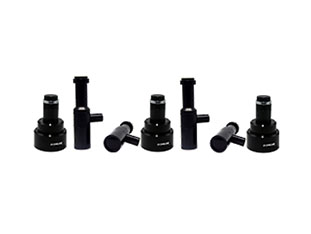What is the difference between a telecentric lens and a parallel light imaging lens?
optical principle
1. Telecentric lens:


① The telecentric lens is designed to correct the parallax of conventional lenses. It makes the main ray of the object side parallel to the optical axis through a special optical structure, so that the magnification will not change with the change of the object distance within a certain object distance range.
② Telecentric lenses are mainly divided into three types: object-side telecentric, image-side telecentric and double-side telecentric. The main rays of the object-side telecentric lens are parallel to the optical axis, the main rays of the image-side telecentric lens are parallel to the optical axis, and the bilateral telecentric lens has the characteristics of both object-side and image-side telecentricity.
2. Parallel light imaging lens:
① Parallel light imaging lenses utilize the properties of parallel light for imaging. Parallel light passing through the lens creates a clear image on the image plane.
② Parallel light imaging lenses usually use a special optical design, such as a combination of mirrors and lenses, to produce parallel light. Such lenses enable high-resolution, distortion-free imaging and are particularly suitable for measurement and inspection applications that require high precision.
Imaging Features
1. Telecentric lens:
① Low distortion: Telecentric lenses are effective in reducing distortion, resulting in a more accurate image shape. This is very important for applications that require precise measurement of the size and shape of objects.
② Constant Magnification: Within a certain range of object distance, the magnification of the telecentric lens remains constant and is not affected by changes in object distance. This makes the measurement results more accurate and reliable.
③ Large depth of field: The telecentric lens has a large depth of field and can clearly image different depth positions of the object at the same time. This is very useful when measuring multiple surfaces of an object or objects with a certain thickness.
2. Parallel light imaging lens:
① High resolution: Parallel light imaging lenses produce high-resolution images that clearly show the details of an object. This is important for applications that require observation and measurement of tiny objects.
② Aberration-free: Parallel light imaging lenses enable distortion-free imaging, resulting in more accurate image shapes. This is useful for applications that require precise measurement of the size and shape of objects.
③ Parallel light characteristics: Parallel light imaging lenses are able to produce parallel light so that light is not scattered or refracted in the propagation process, thus improving the quality and stability of the image.
Application Scenarios
1. Telecentric lens:
①Dimensional Measurement: Telecentric lenses are widely used for dimensional measurement in industrial automation, such as dimensional inspection of electronic components and mechanical parts. It can provide accurate measurement results that are not affected by changes in object distance and object position.
② Machine Vision: In machine vision systems, telecentric lenses are used to identify, localize and detect objects. It can provide clear and accurate images and improve the performance and reliability of machine vision systems.
③ Medical field: Telecentric lenses are also used in the medical field, such as in microscopes, endoscopes and other equipment. It can provide high-resolution, distortion-free images to help doctors carry out accurate diagnosis and treatment.
2. Parallel light imaging lens:
① Precision Measurement: The parallel light imaging lens is suitable for measurement applications that require high precision, such as optical metrology and semiconductor manufacturing. It can provide high-resolution, distortion-free images to meet the needs of high-precision measurement.
② scientific research: in scientific research, parallel light imaging lens is used for observation and study of microscopic objects. It can provide clear and accurate images to help scientists understand the structure and characteristics of objects.
③ Optical Inspection: Parallel light imaging lens is also widely used in the field of optical inspection, such as the inspection of optical components, surface quality inspection. It can provide high-resolution, distortion-free images to help inspectors find and analyze problems.
There are some differences between telecentric lenses and parallel light imaging lenses in terms of optical principles, imaging characteristics and application scenarios. When selecting a lens, you need to choose the right type of lens according to the specific application requirements in order to obtain the best imaging effect and measurement accuracy.
Product recommendation
TECHNICAL SOLUTION
MORE+You may also be interested in the following information
FREE CONSULTING SERVICE
Let’s help you to find the right solution for your project!


 ASK POMEAS
ASK POMEAS  PRICE INQUIRY
PRICE INQUIRY  REQUEST DEMO/TEST
REQUEST DEMO/TEST  FREE TRIAL UNIT
FREE TRIAL UNIT  ACCURATE SELECTION
ACCURATE SELECTION  ADDRESS
ADDRESS Tel:+ 86-0769-2266 0867
Tel:+ 86-0769-2266 0867 Fax:+ 86-0769-2266 0867
Fax:+ 86-0769-2266 0867 E-mail:marketing@pomeas.com
E-mail:marketing@pomeas.com
